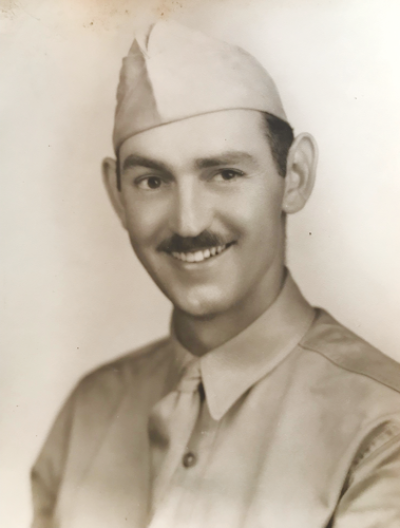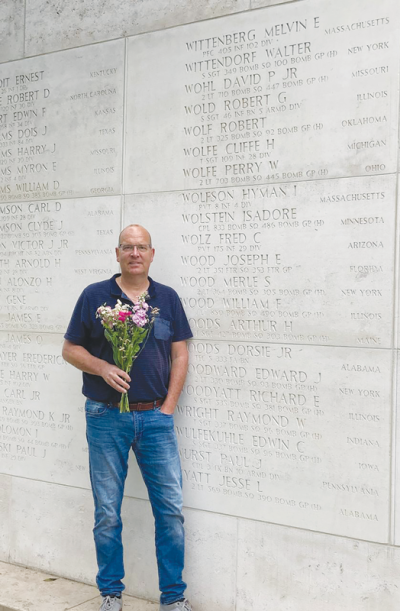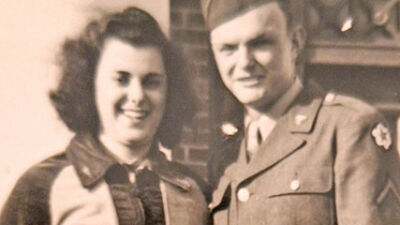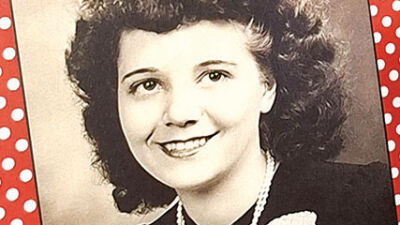
Detroit native Cliffe Hamilton Wolfe, who has been missing in action since November 1944, is among the U.S. soldiers remembered at the Netherlands American Cemetery.
Photo provided by Susan Miller

Bart van der Sterren, a resident of Schinveld, Netherlands, has adopted two soldiers, including Cliffe Hamilton Wolfe, of Detroit. Pictured here van der Sterren stands below Wolfe’s name at the Wall of the Missing.
Photo provided by Bart van der Sterren
METRO DETROIT — Each time Bart van der Sterren visits the Netherlands American Cemetery, he places a bouquet of fresh flowers at the Wall of the Missing.
The heartfelt gesture honors the memory of U.S. soldier Cliffe Hamilton Wolfe, a Detroit native who went missing in November 1944 during World War II. His remains have never been found.
Van der Sterren, a resident of Schinveld, Netherlands, is among many volunteers who have adopted American GIs buried at the cemetery, located in the European town of Margraten, Netherlands.
Approximately 8,300 U.S. military service members killed in combat during Operation Market Garden and the Allied push into Nazi Germany are laid to rest there. Also remembered are the 1,700 soldiers whose names are listed on the Wall of the Missing, including Wolfe’s. The cemetery was built on land where the U.S. Army’s 30th Infantry Division liberated Dutch citizens in September 1944.
Rows of crosses — etched with the deceased soldiers’ names, hometowns and dates of birth and death — line the cemetery’s open fields. Each headstone, along with displayed flags of America and the Netherlands, pay tribute to the U.S. service members who made the ultimate sacrifice. The Dutch people constructed the cemetery to show their gratitude to the U.S. troops who liberated their country during wartime. The cemetery officially opened July 7, 1960.
“It is important that people around the world, especially America, read that these young heroes did not die in vain, but for our freedom more than over 78 years ago,” van der Sterren, a World War II buff, said via email.
Through the Margraten Adoption Graves Foundation, volunteers can adopt an American soldier. Currently, all the graves and names of the Wall of the Missing have been adopted. Because so many people want to pay tribute to the soldiers, sometimes there is a waiting list to adopt. Volunteers bring flowers to remember the service members and also conduct research on their own to learn more about their lives. Van der Sterren said a visitors center was built recently, which he described as “beautiful” and “worth a visit.”
Van der Sterren, 58, who speaks Dutch, German and English, lives about 40 minutes from the cemetery. He visits it four times a year. Each year, a ceremony in honor of the U.S. Memorial Day is held. This year’s event is scheduled for May 26, one day before the official holiday.
This past winter, van der Sterren contacted C & G Newspapers after an article appeared in the Eastsider about someone with a last name that is similar to a soldier buried at the cemetery. He wanted to know if there was a connection, but there wasn’t.
However, there was a local tie from across the Atlantic Ocean because one of the soldiers van der Sterren adopted — Cliffe Hamilton Wolfe — hailed from Detroit. In an email interview, van der Sterren shared details about the service member and the efforts to find his remains, which so far have been unsuccessful.
Wolfe, born in 1913, was a technical sergeant with the 28th Infantry Division, 109th Infantry Regiment, 1st Battalion Company A. He was last seen Nov. 17, 1944, in a forest near the town of Hürtgen, Germany. He is still listed as missing in action.
Going through the proper procedures, van der Sterren obtained Wolfe’s Individual Deceased Personnel File. Inside the file was a map the captain of Wolfe’s troop drew, indicating his last known whereabouts. It is highly suspected that Wolfe lost his life near the village of Hürtgen, southeast of Aachen, Germany.
Wolfe, 31, “died in his own foxhole during combat. Due to the rapid advance of the Germans, Wolfe and others were buried quickly on the spot,” according to van der Sterren’s research. “At the end of the Second World War, there was heavy fighting here, a battle that was given the name ‘death factory.’ The conditions in this period were extremely miserable due to violent enemy artillery fire that sowed death and destruction.”
With the help of various organizations, including the Defense POW/MIA Accounting Agency, van der Sterren tried to find the missing soldier through aerial photographs, metal detectors and ground-penetrating radar.
“After a week of digging in Hürtgen (in 2018) and finding several hidden foxholes containing ammunition, bullets, mortars, hand grenades and personal military items, we were unable to find Cliffe H. Wolfe,” van der Sterren said.
‘I think it’s so nice to have Cliffe’s memory being honored.’
Wolfe’s family members, including nieces Susan (Wolfe) Miller and Nancy (Wolfe) Jordan, found out about the cemetery through van der Sterren. Their dad (Wolfe’s older brother) was Charles Wolfe, who served in the Navy during World War II. After the war, Charles, wife Margaret, Nancy and Susan lived in Detroit for many years. At one time, Charles served as Detroit Public Schools superintendent. He died in 1990.
Nancy was a toddler when Wolfe went missing and Susan was born in 1947, after the war. When Miller found out about the Netherlands American Cemetery, she put together a book of photos and essays about her uncle for van der Sterren. Although Miller has not visited the cemetery, she stays in touch with van der Sterren.
“I think it’s absolutely wonderful the Dutch people have honored the soldiers all these years. I think it’s so nice to have Cliffe’s memory being honored,” said Miller, who now resides in Rochester, New York. “It was such a lovely thing to know the Dutch country was taking care of our uncle who has never been found, but are honoring his sacrifice.”
Although Miller never knew her uncle, she felt his presence through the many stories her father and grandparents told. He was an educator at the Merrill-Palmer Institute in Detroit when he joined the Army in early 1942.
“Cliffe sounded like a lovely person,” she said. “I had a lot of pictures of my dad and Cliffe growing up. He was tall and lanky and very handsome.”
Before the Wolfe brothers left for combat, their parents — Miller’s grandparents — moved to a cottage in Rondeau Provincial Park, Ontario, Canada. At Wolfe’s request, his parents lit a lamp every evening at the cottage in the front window until the boys came home.
Wolfe attended Northwestern High School in Detroit and after graduation enrolled at Wayne State University, when it was called Wayne University. According to information Miller obtained from her sister, who lives in Maryland, Wolfe was in a long-term relationship with a young woman in Detroit when he left for the military.
Miller said her uncle had an interest in the Appalachian Mountains and its people. He even built a cabin nestled in Berea, Kentucky. Miller, too, sensed the pain his loss brought to the family.
“The sadness of Cliffe’s death really hung over my childhood,” she said.
‘Now it’s war time.’
As a keepsake, Miller still has the letters Wolfe wrote to his parents while overseas.
“He was a beautiful writer,” Miller said. “His expressiveness was beautiful.”
In one written correspondence dated Dec. 7, 1942 — exactly one year after the Pearl Harbor attack — Wolfe wrote to his parents about the memories he had of opening presents on Christmas Day, including the year the family got its first-ever Victrola.
“Playing that grand music, we were so thrilled,” he wrote, according to Miller. “Now it’s war time. It’s hard to look into the immediate future.”
In another letter entrusted to the keeping of his chaplain, Wolfe wrote, “Dear Mother and Pop: This may reach you if anything happens to me. I hope and pray that when all of this horrible war is over, I’ll be coming home to you. But ahead of me lies a great deal of danger and life is not very highly valued.
“We will be going into a tremendous battle soon and we all know that many will not live through it. If this should reach you because I’ll not be home, you’ll know, my dears, that my love for you continues eternally in whatever place in the universal realm our Lord has chosen to lead me. I do love you so, Cliffe. “
After Wolfe went missing, the family connected with a liaison officer in an attempt to locate his remains.
“My grandmother wrote 75 to 100 letters from 1945-52,” Miller said. “The military looked so hard for Cliffe and the other soldiers. We know they searched and searched and searched.”
After speaking with the DPAA, there could be another attempt next year to locate Wolfe.
“Hopefully in 2025 another search for his remains will take place together with the DPAA and he will be found,” van der Sterren said. “In letters to his mother during the war, he wrote that if he died during the war, he would like to be buried in his hometown.”
Along with Wolfe, van der Sterren, who is married and has two grown sons, adopted another soldier named Hans Bermayr, who was killed in action Feb. 26, 1945. His hometown was Milwaukee, Wisconsin. Van der Sterren does not want the members of the U.S. armed forces at the Netherlands American Cemetery to ever be forgotten.
For more information on the Netherlands American Cemetery, visit abmc.gov/Netherlands.
 Publication select ▼
Publication select ▼






















